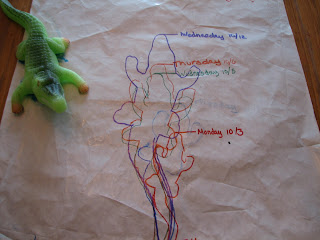Zack's Alligator
You can have your own adventures in science with a growing alligator . (Of course you can use another other "Growing" animal, the alligator just complements the book nicely).
. (Of course you can use another other "Growing" animal, the alligator just complements the book nicely).
Before you place the alligator in any water, take some measurements. The number and type of measurements you take will depend upon the age of your students. Some possibilities:
- Length (nose to tail)
- Width - across the head
- Width - from toe to toe
- Thickness
- Mass
- Volume
- Density (not a measurement, but could be calculated if you have mass and volume data)
I did this with a very young student, for whom measurements are meaningless, so we traced around the alligator. (FYI, I used the back side of a sheet of freezer paper - I could get a nice long sheet of paper, and it's plasticated, which was important since future tracings would be made when the alligator was wet).
- I could get a nice long sheet of paper, and it's plasticated, which was important since future tracings would be made when the alligator was wet).
After measuring, the alligator can be placed in a large tub of water (you want to make sure it has room to grow).
Each day, for about a week, take each of the measurements.
At the end of the week, you'll have a collection of data.
If you have numerical data, you can create graphs that illustrate the rate of growth. You can then analyze whether the alligator grew faster in one dimension than another or if they all grow at the same pace.







No comments:
Post a Comment
Note: Only a member of this blog may post a comment.